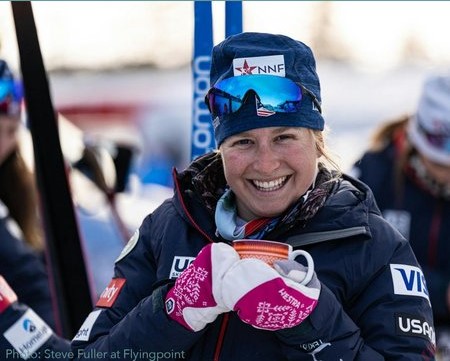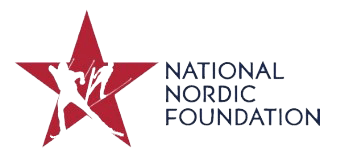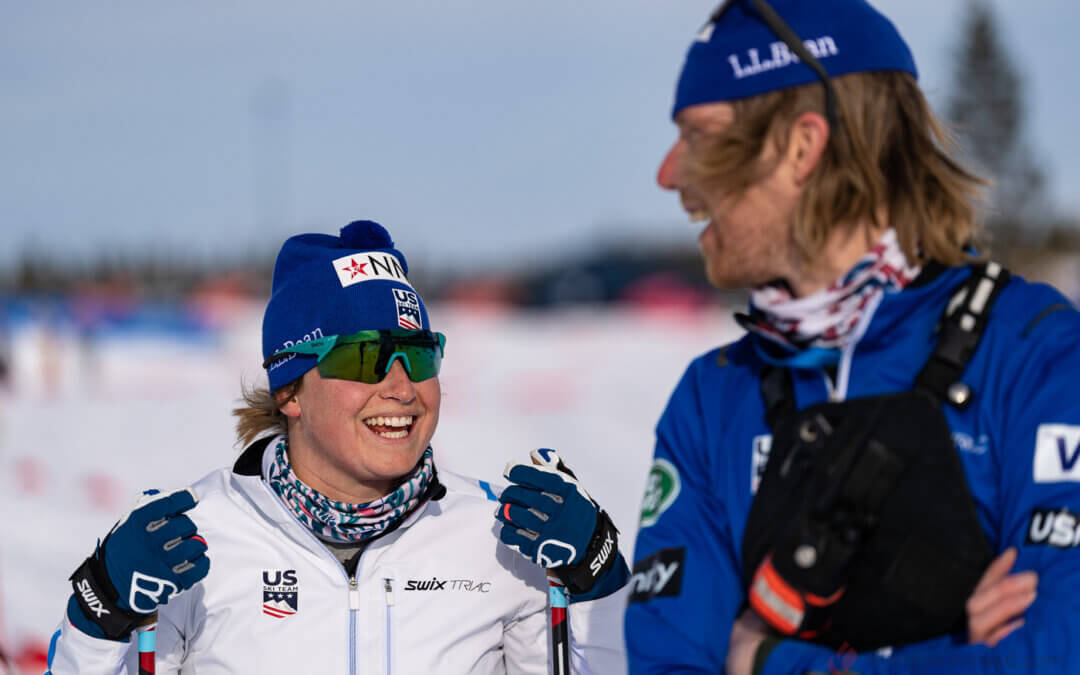The second year of NNF’s Trail to Gold Coaching Grant Program saw eight woman coaches from across US Skiing contribute to what amounted to the most successful World Cup season in American history. From Jessie Diggins’ season-long campaign towards the Crystal Globe, to Gus Schumacher’s emotional Minneapolis win, with a whole lot of podium finishes in between, there was always a Trail to Gold Coach working with the US Ski Team to provide the world-class support required for world-class results this season.
The Trail to Gold Coaching Grant is designed to bring Women coaches to the World Cup for two races weekends at a time, and fully immerse them as part of the US Ski Team coaching and wax technician World Cup team. In its second-year, the ways in which that premise was taken to by the individual Trail to Gold coaches to shape an experience that highlighted their unique talents grew in number and variety. And as the US Ski Team coaches like NNF Board Member Matt Whitcomb have pointed out, that was a total value-added propisition.
With the winter now complete, NNF is catching up with this year’s Trail to Gold coaches to reflect on their experiences on the World Cup, and how it’s shaped their coaching since then. First up, Bridger Ski Foundation Comp Team Coach Julia Hayes!
This interview has been edited for length and clarity.

Ben Theyerl/NNF (NNF): Can you tell us about yourself? Where do you currently coach and where were you on the Trail to Gold this year?
Julia Hayes (JH): I currently coach at Bridger Ski Foundation in Bozeman, Montana. I was on the Trail to Gold from February 25th-March 11th for the first races after the North American World Cups in Lahti, Finland and Holmenkollen in Oslo, Norway, and it was my first time completing the Trail to Gold Coaching Grant.
NNF: What roles did you get to experience as part of the Trail to Gold within the World Cup Staff?
JH: I got to experience a little bit of everything. I spent most of the Lahti races helping the wax staff. Then, more coaching roles in Norway with A LOT of ski testing. At both locations, I was also on course during all the races either taking video or helping with feeds.
NNF: When I caught up with US Ski Team Head Coach Matt Whitcomb last week, he singled-out an experience with you and the US Team staff celebrating each other as a really good distillation of what the US Team was all about this season. What stood out to you about the US Ski Team culture when you were at the World Cup with them?
JH: That was definitely the most memorable aspect of my experience. It was my last night and also happened to be my birthday (which I try to not make a big deal of). Kristen [Bourne] found out and created a spur of the moment party in the wax truck. The entire US Ski Team staff was there, and we talked for hours about what is valuable in the people sitting in that circle. It was very special to feel like I was part of the value added to the team, and not just sitting in hearing what’s great about that particular group of people. I felt like I was really able to form connections with the staff in the short time that I was there.
I felt like that particular experience hammered home how much everyone valued each other far beyond just their role on the staff. What started with pretty “ski-oriented” appreciation turned into everyone taking turns expressing their love for one another and what type of community the staff has been able to create based on mutual respect, curiosity, and innovation. I think that something like team culture is easy to overlook and take for granted on any team, but especially in an individual sport. It is also something that no one except the Team really understands. There is a nonverbal mutual agreement that is formed through behavior and intention. And it is something that is imperative for success for athlete-coach relationships as well as coach-coach, athlete-athlete, athlete/coach-organizer/volunteer/official relationships.
I believe that the US Ski Team has one of the most unique team atmospheres out there. When they say family, they mean it. And I am certain that each T2G Fellow got to be a beloved adopted puppy that was cared for as a member of that family.
NNF: You’ve worked as part of the US Team Staff at other, more develop-level projects. How was this experience as a staff member on the World Cup different than being part of a coaching team at World Juniors or a National Training Group Camp etc..?
JH: It is mostly different because working on development projects like NTG/World Jr’s the Staff comes together (probably jet-lagged) and creates a bubble per say around the event.
Coming onto the World Cup was extremely intimidating entering an established group’s daily routine. It’s a very different vibe. I’d say this was more of an ongoing process instead of a mad rush to test and make skis and coach and make the experience as valuable as possible for the athletes there all at once. You can tell that the World Cup staff are professional, and they pace themselves to get through the long season.
At the end of the day, both the World Cup and the Development Projects NNF supports are aiming for a similar outcome. It’s just a matter of where you’re coming and going from. At the development level, the end of the event comes, you leave, return to your club, and reset, but at the end of a World Cup weekend, you pack up and head to the next race and do it all over again with the same people.
NNF: Looking back, was there a key lesson you took from your Trail to Gold experience that stands out?
I think that no one knows it all. We are constantly learning and growing within our environment and the best/only way to do that is through collaboration and humility. Not a single person or nation ever has the “right” answer when it comes to coaching or ski tech-ing.
The more you believe that you have something to offer, the more others’ believe it, and that confidence can come in a lot of different forms.

US Ski Team Staff during the “Julia Hayes” surprise birthday party in Oslo, Norway. (Photo: Courtesy Image/Matt Whitcomb)
SUPPORT THE TRAIL TO GOLD!




Recent Comments